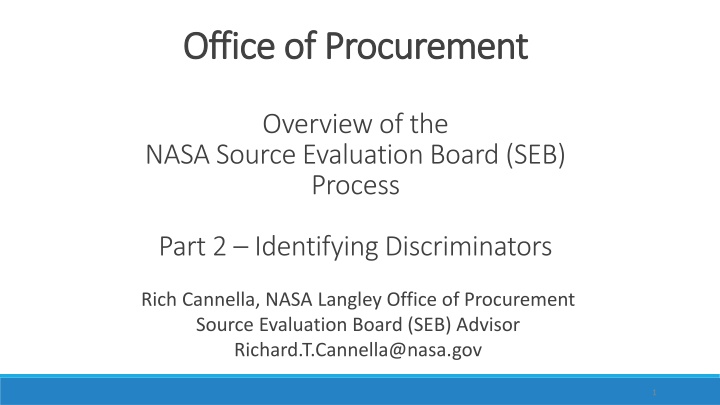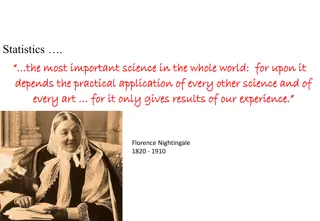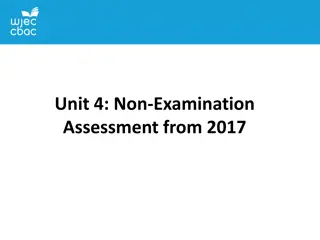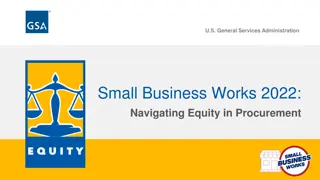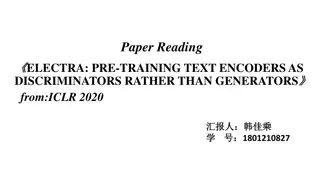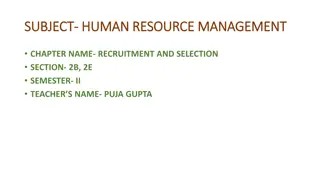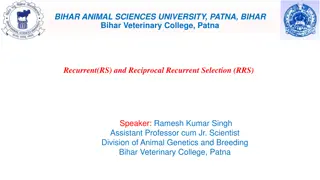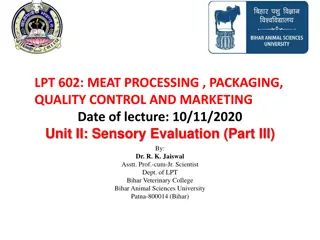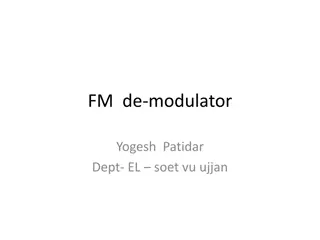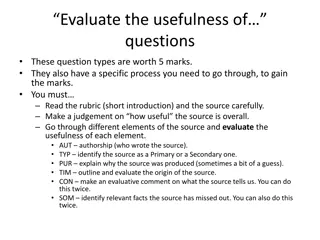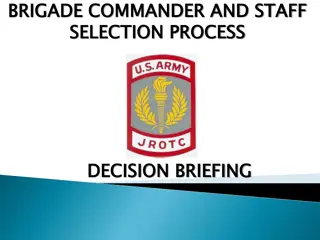Enhancing Source Selection Through Discriminators and Evaluation Factors
This content discusses the identification of key discriminators in the NASA Source Evaluation Board process, emphasizing the importance of selecting discriminators effectively to streamline the acquisition process. It also covers areas of significance in making meaningful comparisons between competing proposals and highlights the factors that enhance or degrade successful contract performance. The text stresses the importance of clear and unambiguous evaluation factors and subfactors in the tradeoff process for contract awards.
Download Presentation

Please find below an Image/Link to download the presentation.
The content on the website is provided AS IS for your information and personal use only. It may not be sold, licensed, or shared on other websites without obtaining consent from the author.If you encounter any issues during the download, it is possible that the publisher has removed the file from their server.
You are allowed to download the files provided on this website for personal or commercial use, subject to the condition that they are used lawfully. All files are the property of their respective owners.
The content on the website is provided AS IS for your information and personal use only. It may not be sold, licensed, or shared on other websites without obtaining consent from the author.
E N D
Presentation Transcript
Office of Procurement Office of Procurement Overview of the NASA Source Evaluation Board (SEB) Process Part 2 Identifying Discriminators Rich Cannella, NASA Langley Office of Procurement Source Evaluation Board (SEB) Advisor Richard.T.Cannella@nasa.gov 1
Areas of importance and emphasis that support meaningful comparisons and discrimination between and among competing proposals Key discriminators set the stage for the source selection strategy/approach, not the reverse (common mistake) Identifying key discriminators will streamline the acquisition process Too many diminish the importance of the true discriminators essential for the SSA s tradeoff and selection decision Allows distinct aspects of offerors proposals to stand out, again essential the SSA s tradeoff and selection decision. Langley has been identifying key discriminators for decades, so be aware that an item that may not be a discriminator may be of no less importance just not a discriminator may be evaluated differently (i.e., pass/fail factor, responsibility, only for apparent awardee)
Source Selection Evaluation Factors Enhancements Drawbacks SUCCESSFUL CONTRACT PERFORMANCE Improve Degrade Value Added .Reduces Value Decreases Risk .Increases Risk Benefits *No Benefits Impacts .(Good or Bad) 4
Source Selection Evaluation Factors Just because the terms key and streamlines are used doesn t make it so test of a good discriminator . clear and unambiguous is additive minimizes offerors expense and response time, minimizes Government s expense, evaluation effort, and lead time, impacts the SSA s comparative analysis and selection decision read the selection statement doesn t mean not important if it didn t impact, just did not result in a distinction among offerors Did Not Impact -- Overall, I did not note any discriminators in this area. Did Impact -- provided greater benefit in the area contributes to the selection of the best value offeror * A prior source selection statement may not be predictive of the future 5
Source Selection Evaluation Factors FAR 15.101-1 Tradeoff Process Evaluation factors and significant subfactors that will affect contract award relative importance clearly stated Permits tradeoffs among factors and allows the Government to accept other than the lowest price if the perceived benefits of a higher priced proposal merits the additional cost. Technical factors are broadly defined and include all factors that will be considered in the award decision and typically included in the Technical Proposal (e.g., Mission Suitability volume or other technical proposal) Can be Trade-off Discriminators (Meets, Exceeds, Does Not Meet or other approach) Can be Pass/Fail Factors (Acceptability) Past Performance Price Trade-off (PPTO) PPTO essentially combines the characteristics of Lowest priced technically acceptable associated with the technical considerations and trade-off among the Past Performance and Price/Cost factors The technical considerations are the technical factorsto assess acceptability (pass/fail). Crucial to understand the importance of achieving acceptable to continue in the competition 2
How Do We Select Evaluation Factors? BRAINSTORM Understanding scope Accomplish scientific & technical objectives Availability & competence of experienced STEM personnel Experience Other R&D Eval Factors FAR 35.007/008 FAR 52.212-2, Factors in evaluating commercial Item orders Requirement Analysis FAR 19 Small Business Market Analysis & Research Evaluation Factors - Discriminators NFS 1815.304 SBU 1815.304-70 NASA Eval Factors - Acceptability Risk Assessment FAR 15.304 Eval Factors & Sig Subfactors Internal & External Stakeholders Qualitative & Quantitative Measures 7
How Do We Select Discriminators? Responsibility Submittals Submittals Technical Acceptability Mission Suitability Past Cost or Price Performance
How We Select Discriminators (Contd)? More is not better Too many discriminators tend to get diluted (diminishes the importance) or lost altogether---Impact, not true discriminators in the selection decision Difficult for industry to decipher what is really important Harder for the SSA to pick out the significant differences among competing proposals Limit to the essential performance requirements and/or outcomes Entire SOW/Specification is binding, so you don t have to evaluate everything Must be determinant not just important Just because it isn t evaluated doesn t mean it isn t important, just not a discriminator Areas likely to reveal substantive differences related to technical approach, risk, and/or cost Support meaningful comparison and discrimination between and among competing proposals o Clear and Concise Not vague and ambiguous understandable related to outcomes/consequences, trade-offs, and SSA Selection o Relationship to the desired outcomes/consequences (successful performance, risk mitigation, etc 9
What To Focus On Everything, but Pay close attention to the Proposal Preparation Instructions (Section L) oUnderstand the different proposal submissions/volumes: Trade-off Evaluation Factors Mission Suitability, Past Performance, and Cost/Price Acceptability (Pass/Fail) Evaluation Factors Eligibility Requirements (e.g., OCI, security level) Business Volume Responsibility Considerations (e.g., accounting system, adequate facilities) Business Volume Fully understand the Evaluation Factors for Award (Section M) oBasis of Award Responsible, conforms to solicitation requirements, and determined by the SSA to be the best value based on the evaluation factors and relative importance oMethod of Evaluation Langley does not have a separate Evaluation plan, it is not a mystery because we provide a good overview in the solicitation and use practices consistent with the FAR, NASA FAR Supplement, and the NASA Source Selection Guide oRelative Importance of Evaluation Factors ( The Riddle ) 10
NASA Source Selection Guide Reminders from the NASA Source Selection Guide: Factors/subfactors should be customized and tailored to each procurement based on the requirements, risk assessment, market research, and other factors. Prioritize the list of requirements office needs for the procurement based on the assessments described above to determine the key discriminators. The prioritized list of factors/subfactors will establish the uniform baseline against which an offeror s proposal is evaluated to determine if it meets the solicitation requirements and its overall value to the Government. The prioritized list of factors/subfactors should be used to determine which source selection process is appropriate for the acquisition. The prioritized list of factors/subfactors should represent those specific characteristics that are tied to significant requirements having an impact on the source selection decision and that are expected to be key discriminators. The Source Selection Authority (SSA) approves the source selection process and factors/subfactors. 11
Potential Changes & Trends o Diversity, Equity, Inclusion, and Accessibility (DEIA) o Future of Work Hybrid Solutions Virtual Environments Smart Solutions o Enterprise Operating Models for Product Service Lines o Small Business Utilization o Total Compensation Plan o FAR 52.222-46, Evaluation of Compensation for Professional Employees o NFS 1852.231-71, Determination of Compensation Reasonableness o Assessment of Programmatic Risk o More emphasis on enhancements and improvements 12
Takeaways o Read the solicitation thoroughly, focus heavily on Sections L & M but don t forget other solicitation requirements (e.g., Section K Reps and Certs) Offeror s discretion if it chooses to respond outside the criteria; however, if not relevant to the factor it will likely not be considered and could even negatively impact (e.g., reflects a lack of understanding) o Write to the evaluation discriminators and pass/fail factors which reflect what will be assessed by the SEB and considered in the SSA s integrated assessment and selection o Ensure consistency across proposal volumes and that you followed the Section L instruction regarding what goes in each volume (e.g., Subcontracting Plan) o NASA will not consider information in other proposal volumes unless specifically identified/requested in the solicitation (e.g., Subcontracting Plan) o Include impact statements, consequence statements, or what statements that identify how the approach benefits NASA or the program/project; consider/mitigate risks associated with the approach 13
Takeaways (Contd) EXAMPLE OF A PASS/FAIL FACTOR OR SUBJECTOR THAT CAN EXCLUDE AN OFFEROR 3 SMALL BUSINESS UTILIZATION All offerors shall submit the below information in response to subparagraph (a), All offerors, except small business offerors, shall respond to subparagraph (b). (a) Affirmation statement of the offeror s commitment to the Small Business program, by briefly describing work that may be performed by small businesses demonstrating the extent of commitment to utilize small business concerns and to support their development. Information provided should include a description of established or planned procedures and organizational structure for small business outreach, assistance, participation in the Mentor Prot g program, counseling, market research to identify potential small business sources, and relevant purchasing procedures that foster small business involvement, as applicable. (b) Affirmation statement that the offeror will meet the subcontracting plan requirement of this RFP (See FAR 52.219-9, Small Business Subcontracting Plan, Alternate II) that are applicable to other than small businesses and acknowledgement that the apparent successful other than small business shall be required to submit a subcontracting plan with its proposal in accordance with Section L.22(iii). 14
Takeaways (Contd) CAUTION!!! oMore consistency across the agency does not mean solicitations will be the same oDo not rely on what was done the last time oTake advantage of RFIs, sources sought, pre-solicitation notices, industry conferences, and draft notices/solicitations to ask questions oRegardless of what was said prior to the RFP, the final RFP takes precedence oJust because something isn t a discriminator , doesn t mean it is of less importance oFailure to meet a pass/fail criteria may result in an unacceptable proposal 15
